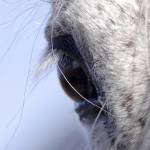Eye Problems in Horses Diagnosed with HERDA

Horses diagnosed with hereditary equine regional dermal asthenia (HERDA) often have skin-related problems, but researchers have uncovered certain eye disorders, specifically corneal conditions, that might also be linked to the disease.
Scientists at Mississippi State University reviewed the eye health of 10 Quarter Horses diagnosed with HERDA as well as 10 horses without HERDA. Additionally, retrospective data from 319 horses (28 with HERDA, 291 without) gathered over a four-year period were also used. Various procedures were implemented to determine eye health: ophthalmic examinations, Schirmer tear tests (measures tear quantity), tonometry (measures eye pressure), corneal pachymetry (measures cornea thickness), histologic examinations, and scanning electron microscopy.
According to the authors, “Alterations in corneal thickness, arrangement of collagen fibers, and incidence of corneal ulcers indicated that abnormalities in horses with HERDA were not limited to the skin.”
Owners of horses definitively diagnosed with HERDA should be especially mindful of eye injuries or vision irregularities, and they should alert their veterinarians of the horse’s HERDA status if an ocular problem occurs.
HERDA, also known as hyperelastosis cutis, is an inherited disorder that affects connective tissue. Weakened collagen fibers cause extremely fragile skin, which often separates between the deep and superficial dermis layers. Most affected horses have to be euthanized when common wounds fail to heal.
The full article, titled “Ocular findings in Quarter Horses with hereditary equine regional dermal asthenia,” was published in the August 2010 issue of the Journal of the American Veterinary Medical Association.








